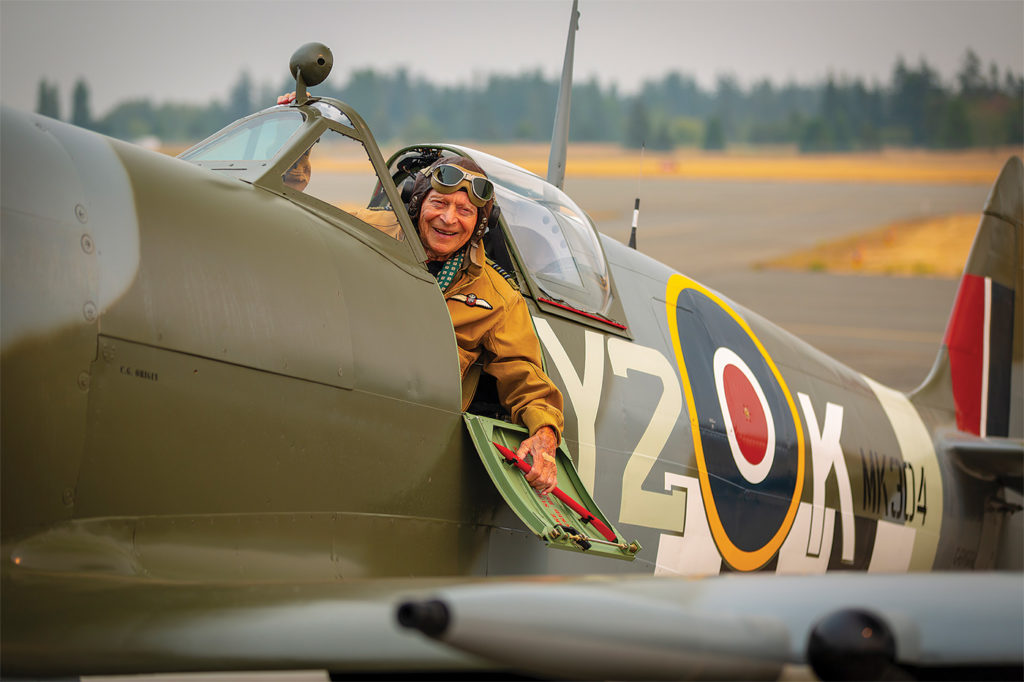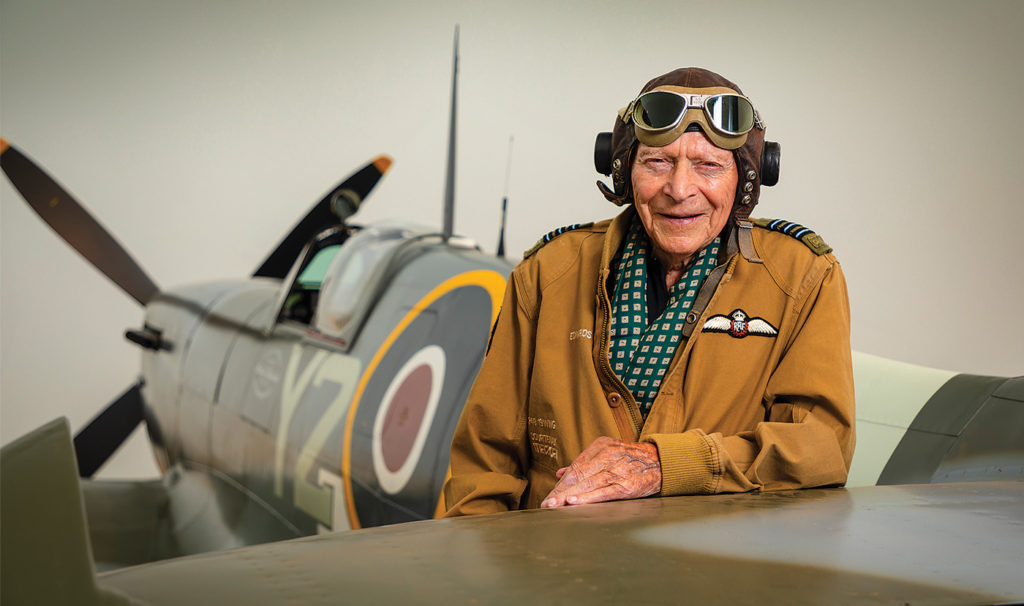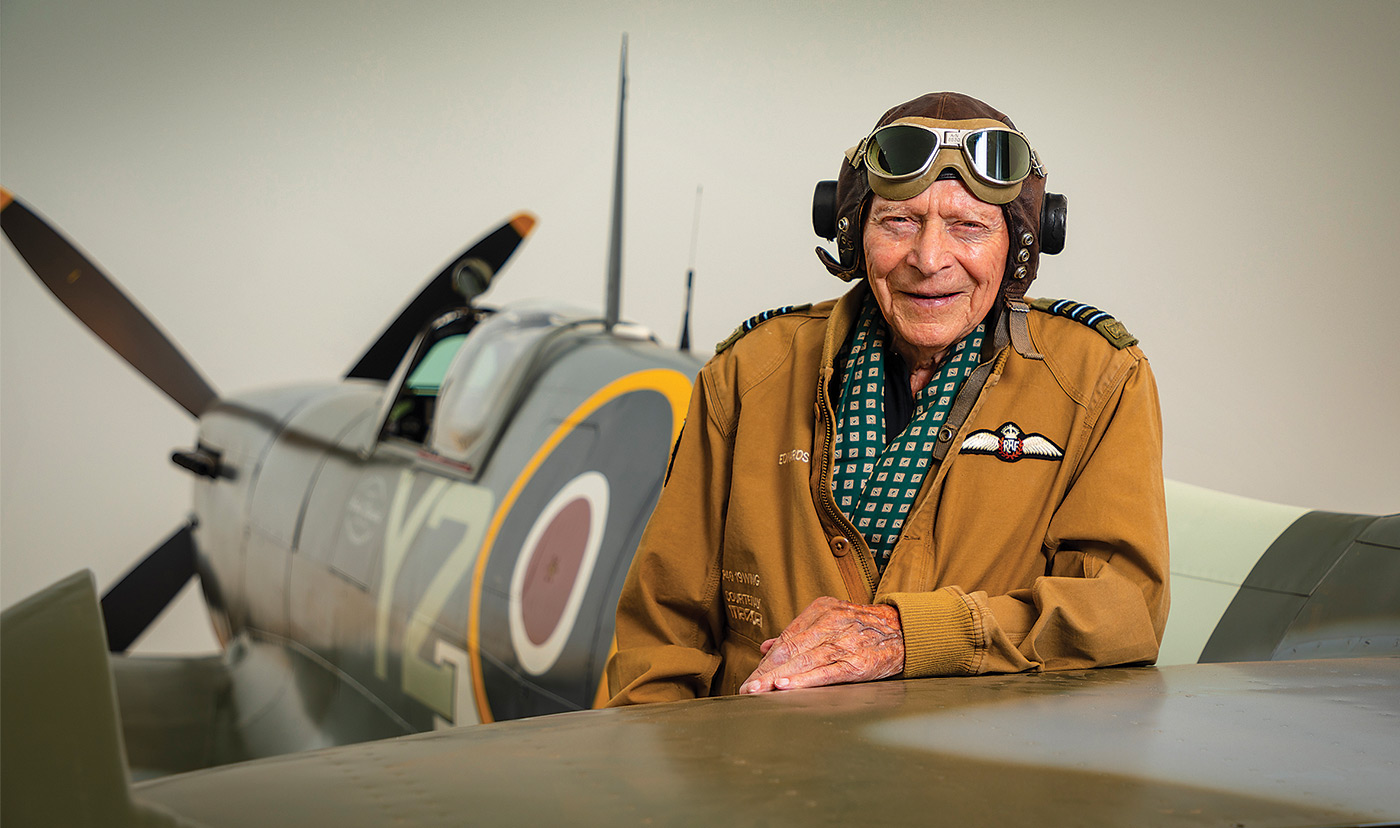Estimated reading time 8 minutes, seconds.
Stocky strode in, and with a firm handshake the interview got started.

Above his warm smile were two keen eyes, seemingly sizing me up. I had prepared questions, but they were quickly forgotten. We simply chatted like any two flyers.
Soon, hands waving in traditional fighter pilot semaphore, he was recalling how best to turn a P-40 Kittyhawk fighter against a Messerschmitt Me-109. He praised the climb rate of the Spitfire, and poked fun at the claustrophobic Hurricane. He would know. Stocky flew them all.
It’s worth taking stock of the moment: Wing Commander James Francis “Stocky” Edwards, CM, DFC & Bar, DFM, CD, aged 97, decorated Second World War fighter ace, looked like he had just landed. I expected to see telltale rings around his ears from his helmet, or some chafing on his neck from his parachute harness.
THE Y2K SPITFIRE
Despite appearances, Stocky didn’t just saunter in after landing a Spitfire, although there was one parked just outside. After an involved trans-Canada restoration, the “Y2K Spitfire,” had returned to its spiritual home at 19 Wing Comox, B.C., where its restoration process had begun almost two decades earlier.
In 1999, a group of volunteers from the Comox Air Force Museum uncrated the remains of a former South African Air Force Spitfire Mk. IX. It consisted mainly of rusty, twisted bits of metal, but they had bold plans to restore and fly it with the call letters “Y2K” as they appeared in service overseas with 442 Squadron.

Vintage Wings of Canada, based in Gatineau, Que., acquired the project when the Comox group succumbed to financial pressures, with the understanding that once complete, the Y2K Spitfire would pay Comox a visit.
That visit began on the afternoon of Tuesday, July 31, when experienced warbird pilot Dave Hadfield landed the Y2K Spitfire at Comox.
Stocky Edwards was there to meet it.
SPEAKING FOR HEROES
Something about museums always disappoints me. Even artifacts that were witness to the most dramatic events in our history offer only mute testimony once entombed in a glass case. A Spitfire in a museum just sits there; but a real, flying Spitfire is a different thing. It hisses and drips and, if provoked properly, erupts into a satisfying roar. Pilots talk in hushed tones about the Spitfire, as if it were a living thing. It’s such a pity that the Spitfire can’t talk.

But Stocky was there. He can speak for the Spitfire, and for the boys who fought in it. His voice can relate the graceful arc of a loop or describe the mortal perils of air combat. He got to live a full life, fulfilling the wishes of many wartime comrades who didn’t share his luck or skill.
One such comrade was RCAF Flight Lieutenant Arnold Roseland, a skilled and well-respected pilot who lost his life during a fighter sweep in France in 1944, while flying on operations with 442 Squadron.
The Y2K Spitfire, now part of the Michael Potter Collection in Gatineau, is dedicated to Roseland’s memory; and like all of the aeroplanes in the collection, it stands as a testament to the sacrifices of individual pilots who flew in defence of Canada. Among the aircraft in the collection, for example, is a Curtiss P-40 Warhawk fighter painted in the exact colours of the one that Stocky Edwards flew in North Africa.

The Spitfire Mk. IX, now also called the “Roseland Spitfire,” joined the flying collection last summer.
I asked Stocky how it felt, after so many years, to see a Spitfire fly over his Comox home. His eyes gleamed. Stocky clearly still has a soft spot for the Spitfire.
“If that Spitfire could speak, what would it say?” I ventured.
Stocky wasn’t feeling sentimental.
“The plane would say, ‘I have the wrong letters painted on me!'” He meant it should have his own initials, “JF-E.”
My pen stopped, and I looked up slowly, but Stocky was smiling; his joke betraying the natural competitiveness of a fighter pilot. But I wondered if he wasn’t also making a point.
TAKING CHARGE
Stocky Edwards didn’t distinguish himself in war merely as a crack shot with keen eyesight. Progressing from a non-commissioned flight sergeant to wing commander demonstrated a different type of competence. Stocky Edwards was a take-charge kind of guy.
After receiving his RCAF pilot wings, in early 1942 Stocky was posted to RAF 94 Squadron in North Africa. In March, he downed an enemy fighter during his first operational mission. Within the year, he had six combat victories, had been commissioned, and had been awarded both the Distinguished Flying Medal and the Distinguished Flying Cross, by then serving as a flight commander with RAF 260 Squadron.
By early 1943, Stocky was given command of RAF 274 Squadron, flying Spitfires, first in Italy and later at RAF Station Hornchurch in England. His 23rd birthday was on the eve of D-Day. After an instructional tour in Canada, flying Anson and Crane trainers, Stocky was sent back to England, where he was promoted to wing commander, commanding RCAF 127 Wing until the end of hostilities.

I asked about his stunning wartime rise through the ranks, and about whether he felt well prepared to assume leadership. Stocky’s answer was so animated that I thought he was about to rise from his chair.
“Oh, I wanted to lead!” he said. “I was schooling myself to be a senior officer.”
Why? Was it ambition? Natural competition among fighter pilots? Wasn’t the war already dangerous enough?
“To save lives,” he replied humbly. While Stocky admired the RCAF’s flight training, he had nothing positive to say about its combat tactics or leadership, and felt that his squadron was losing pilots unnecessarily.
He stepped forward to lead, often increasing his exposure to harm, simply because he knew that it was the right thing to do. Asked whether he received any formal leadership training from the Air Force, he replied, “None.”
But with his index finger raised for emphasis, Stocky dismissed leadership training, emphasizing his contention that under stress, leadership ability comes naturally to a relative few.
It was in that capacity, as a leader of men, that Stocky found his stride.
By the war’s end, Stocky Edwards had flown an incredible 373 combat missions, shooting down 19 enemy aircraft, of which 18 were fighters, without being shot down himself. After the war, Stocky stayed in the RCAF, flying Vampire, CF-100 and Sabre fighters, retiring in 1972.
PLANNING FOR THE FUTURE
In light of his commitment to leadership, it is hardly surprising that he lent his name to the Stocky Edwards Legacy Trust. It is a charitable fund, administered through the Royal Canadian Air Force Association (RCAFA), offering financial incentives to encourage youth to demonstrate excellence in the Royal Canadian Air Cadet programs. Bursaries are available for those pursuing careers in aviation. (For more information see www.y2kspitfire.ca.)

Stocky describes the Trust with the same infectious enthusiasm as he did the Spitfire. That’s Stocky, it seems.
He was a key supporter of the Y2K Spitfire restoration project for two decades before he saw it fly; and now, he’s directing his energies to where he foresees a need–providing for the development of future aviators.
If the Spitfire had a voice, it would indeed sound like Stocky: steady, confident and decisive. Stocky Edwards is a leader.


This kind of pilot should never be forgotten
On the eve of Remembrance Day 2018, while all the men and women who have given the ultimate sacrifice for their country are rightfully the focus of our thoughts, it’s important to note, as Rob’s story well points out, our heroes are not all gone. A wonderful story that subtly emphasizes the exceptional opportunity that we still have to be able to say thank you to those who have served and survived.
What a man, what a life.
Great to hear stories about our Canadian pilots from WWII great read. Thank you for the information about this Vet.a
Regarding the photo caption: “Stocky Edwards always has been a take-charge kind of guy. Here, he settles into the Roseland “Y2K” Spitfire that was rescued from a South African scrap heap by volunteers in Comox, B.C. Heath Moffatt Photo”
Not correct, TE294 was “rescued” from the South African scrap yard by Mark de Vries who started the restoration when he lived in South Africa. Mark brought the project with him when he moved to Canada with the intentions of continuing the restoration but due to health reasons, sold it to the Comox museum.
what a wonderful story – thank you. Our father W. Barry Needham, also a Saskatchewan boy who received his wings the same day & location as Stocky, would have been pleased. We are forever thankful for the memories, stories & experiences that dad shared with us many that included Stocky.
My Dad, Robert Weller received his wings in October 1943 and was also stationed at Comox, BC. He loved the RCAF.
Great to see this article. My father, Len Wilson, flew Y2K operationally while attached to 442 Squadron in Northern Europe. I am thrilled to see this aircraft flying again and will be over to Gatineau for a visit!
Great story, he is one amazing flyer!. Too bad that there isn’t a two seater in Canada like the one operating in England. I bet he would really enjoy one more spin in a spit!
Why isn’t there a movie about him ?
What a fantastic read that was. We had a Spitfire and Hurricane fly over Captain Tom today in England to celebrate his 100th birthday. Hope you guy’s got to see it in Canada
We saw it! What an amazing moment for Captain Tom. He is a true inspiration.